greengekho
Tuesday, December 11, 2012
Thursday, September 23, 2010

Labels: compost, compost at home, daily dump, easy compost
Wednesday, April 7, 2010
Green laundry soap
Good old laundry soap

Each time I get my bout of eczema, I think of those nuts, if I could have some of those then it would be less painful. And as I write this I have both my hands skin peeled, cause of eczema and the pril,surf … I use.So this weekend I have to get hold of the precious ‘soap nuts’ ,which the company is marketing even for washing machine. So it’s going to be less painful for the clothes as well. And not say about the water I will save for the ‘extra rinse’ I use…
So now I surely will have to buy that compost unit!!!
More info: http://www.dailydump.org
Labels: green laundry soap
Thursday, March 18, 2010
LPG stations in Pune
Labels: LPG stations in Pune
Tuesday, March 9, 2010
Bt contaminating organic cotton
Bt contaminating organic cotton
If this is the fate of cotton, without real intervention we will not be able to preserve our local Brinjal varieties.
Labels: Bt traces in Organic cotton


